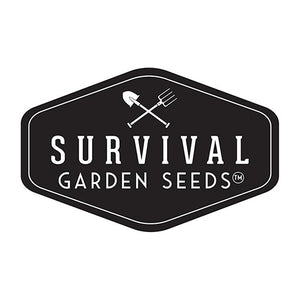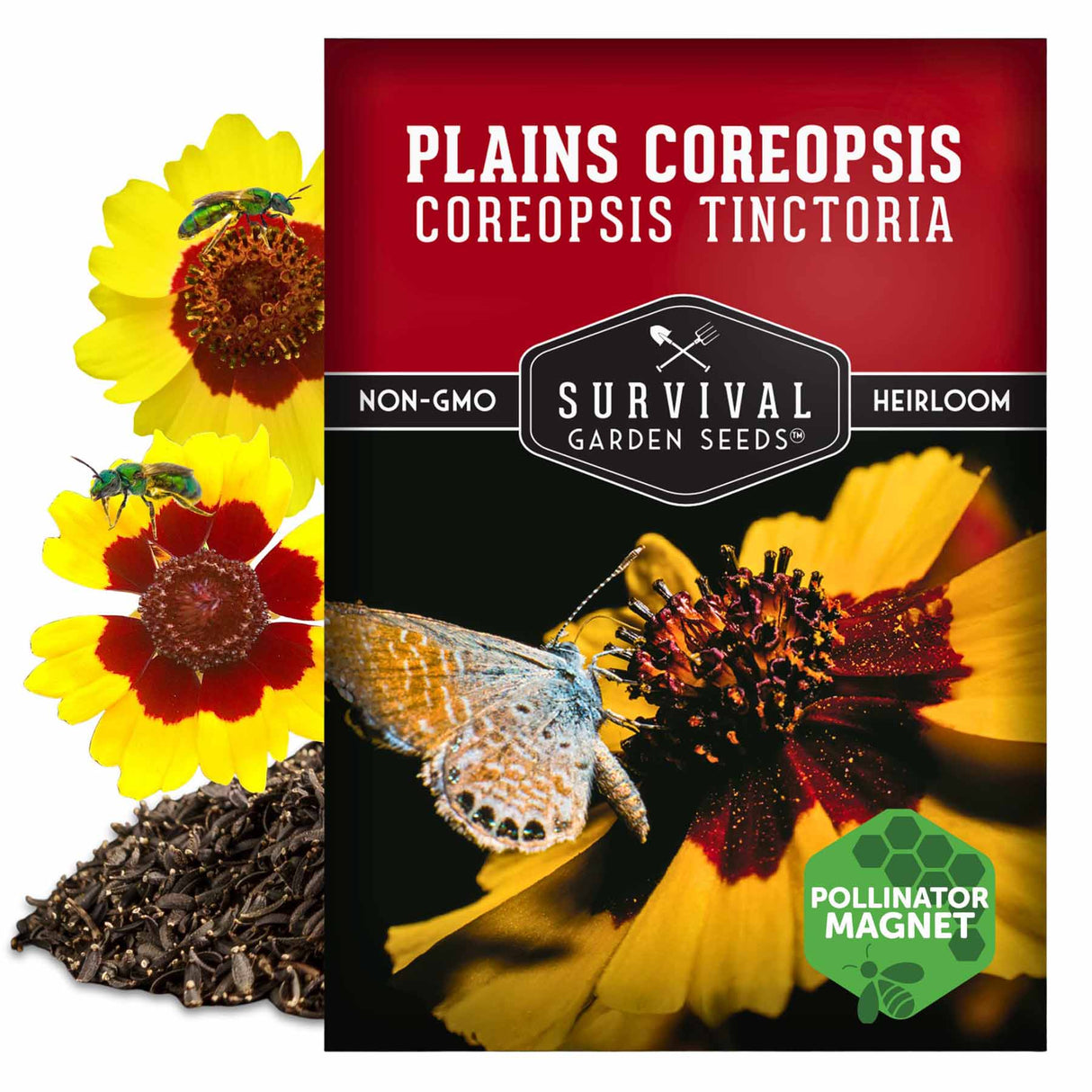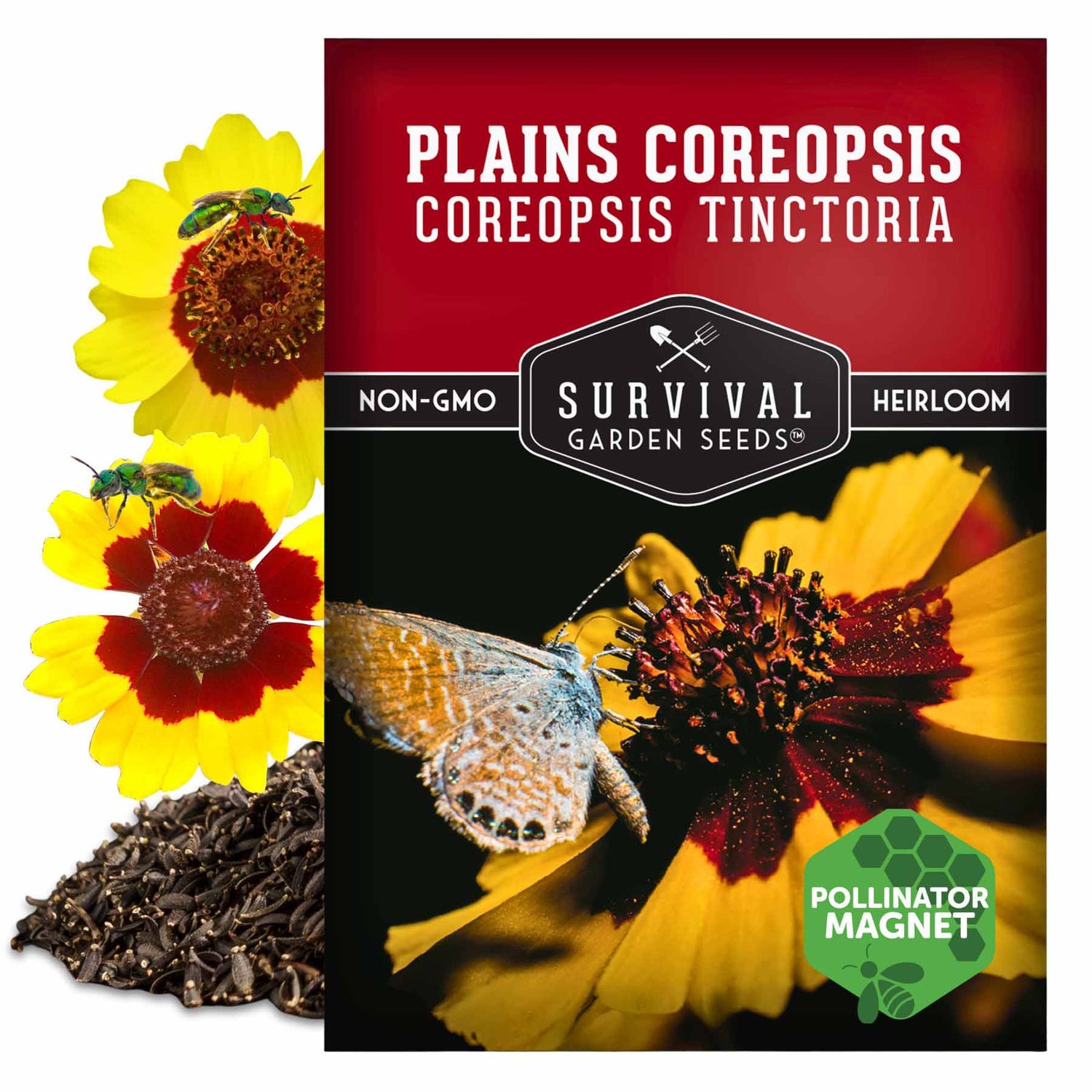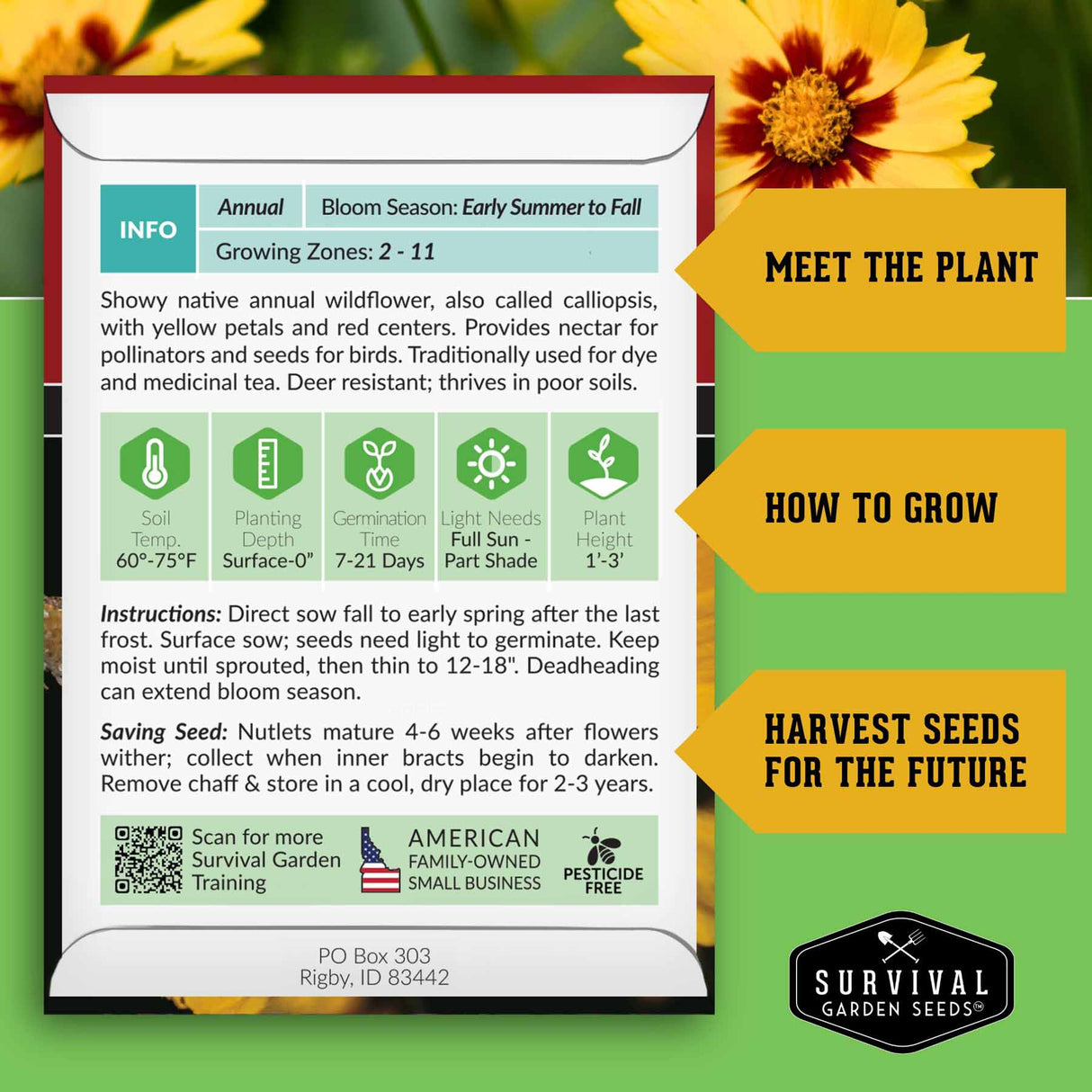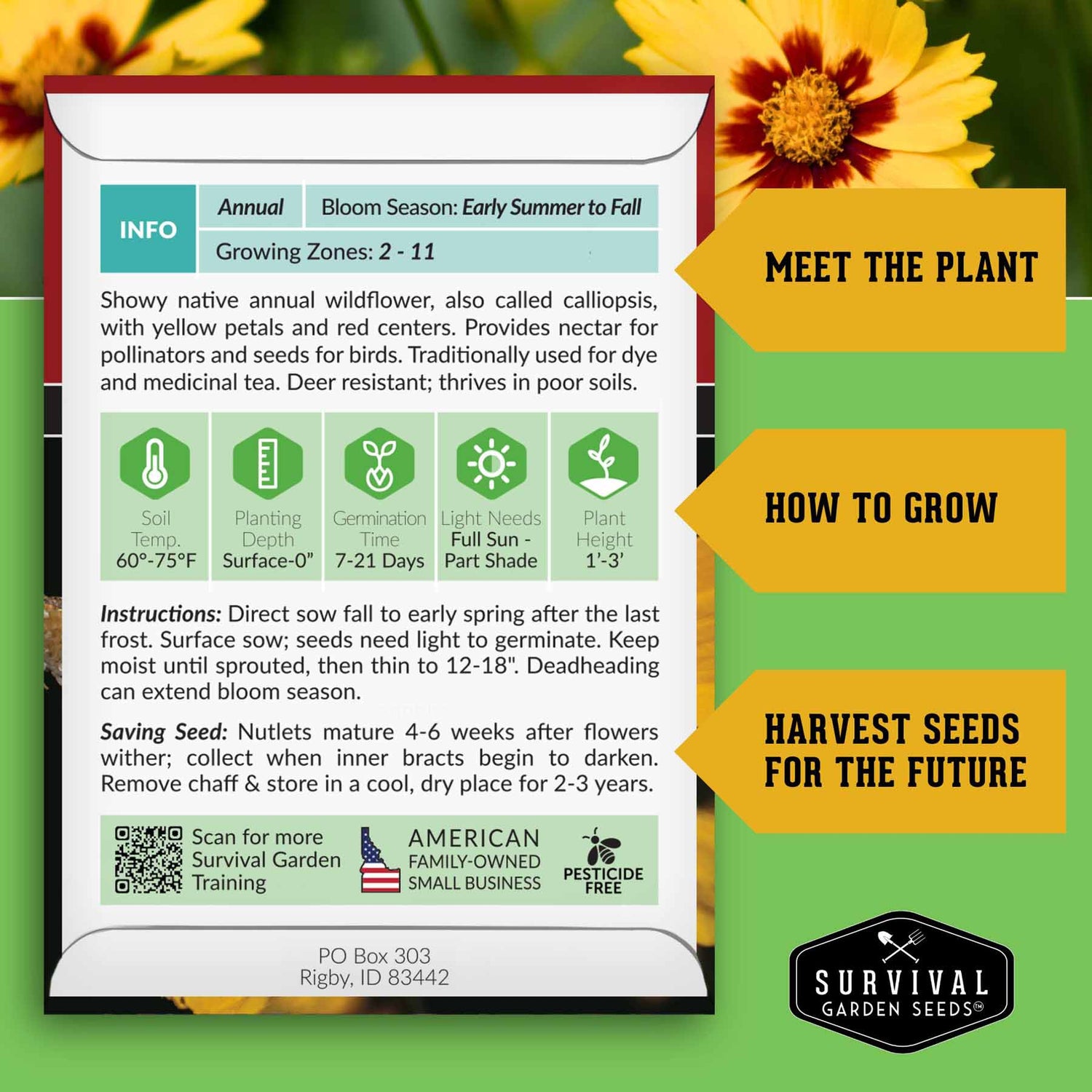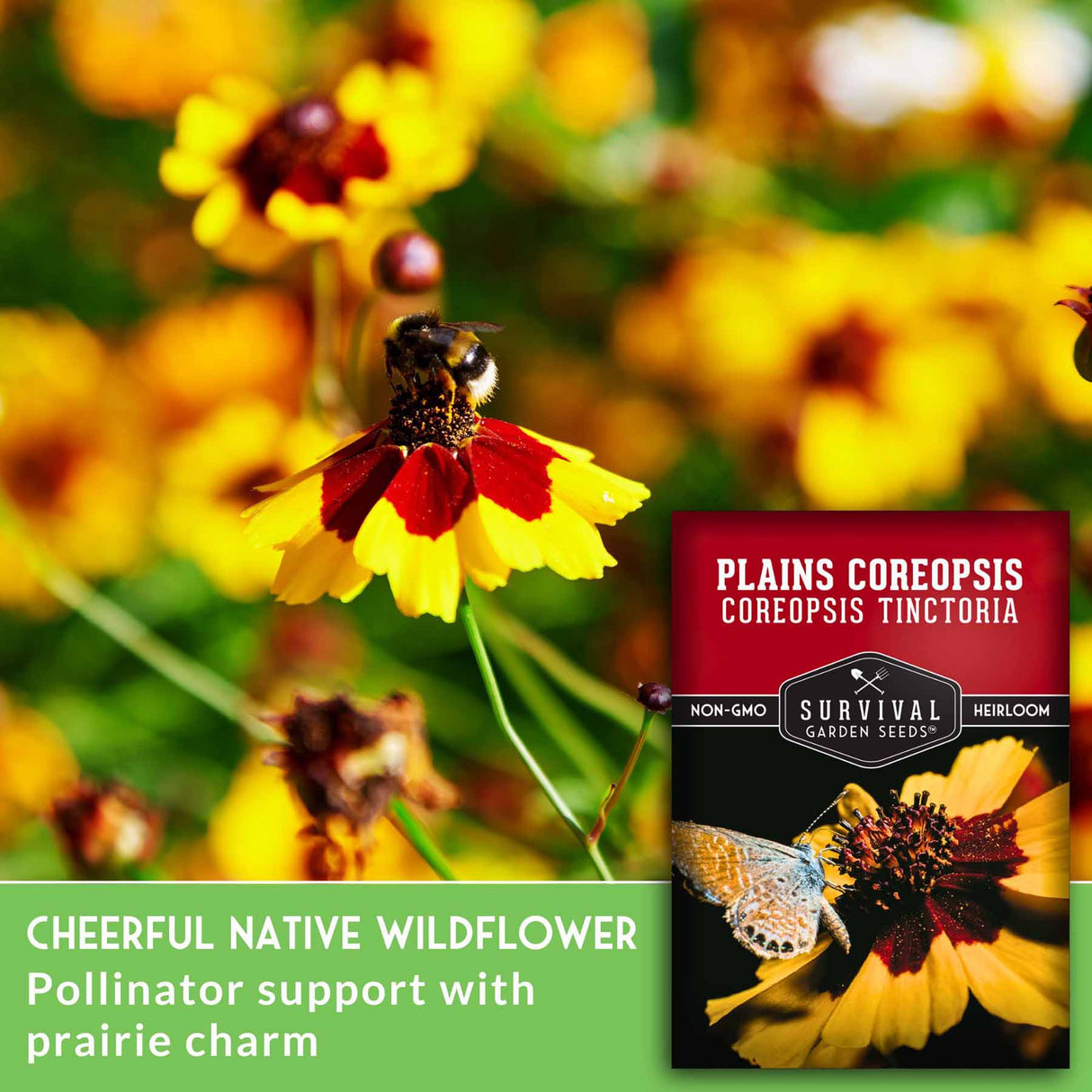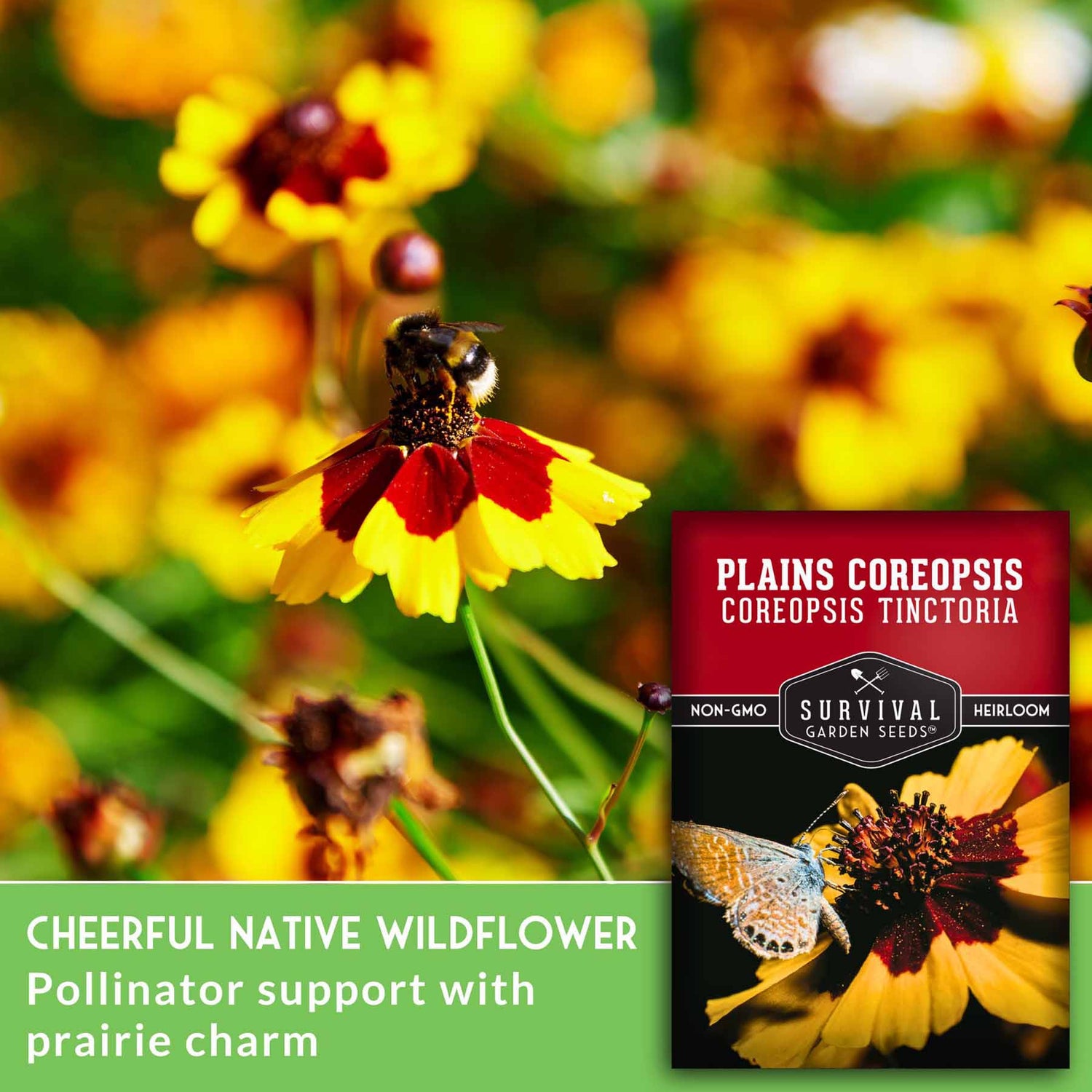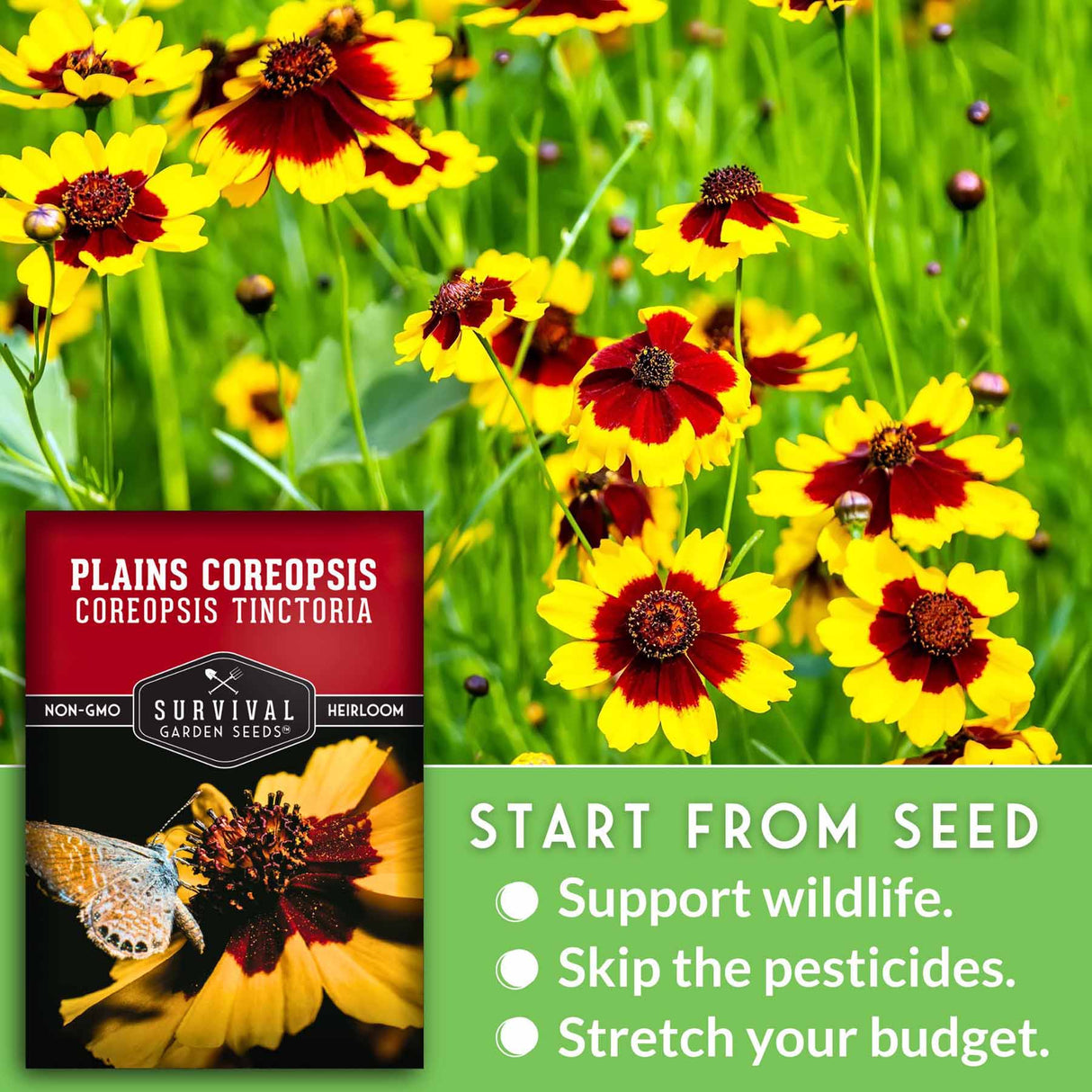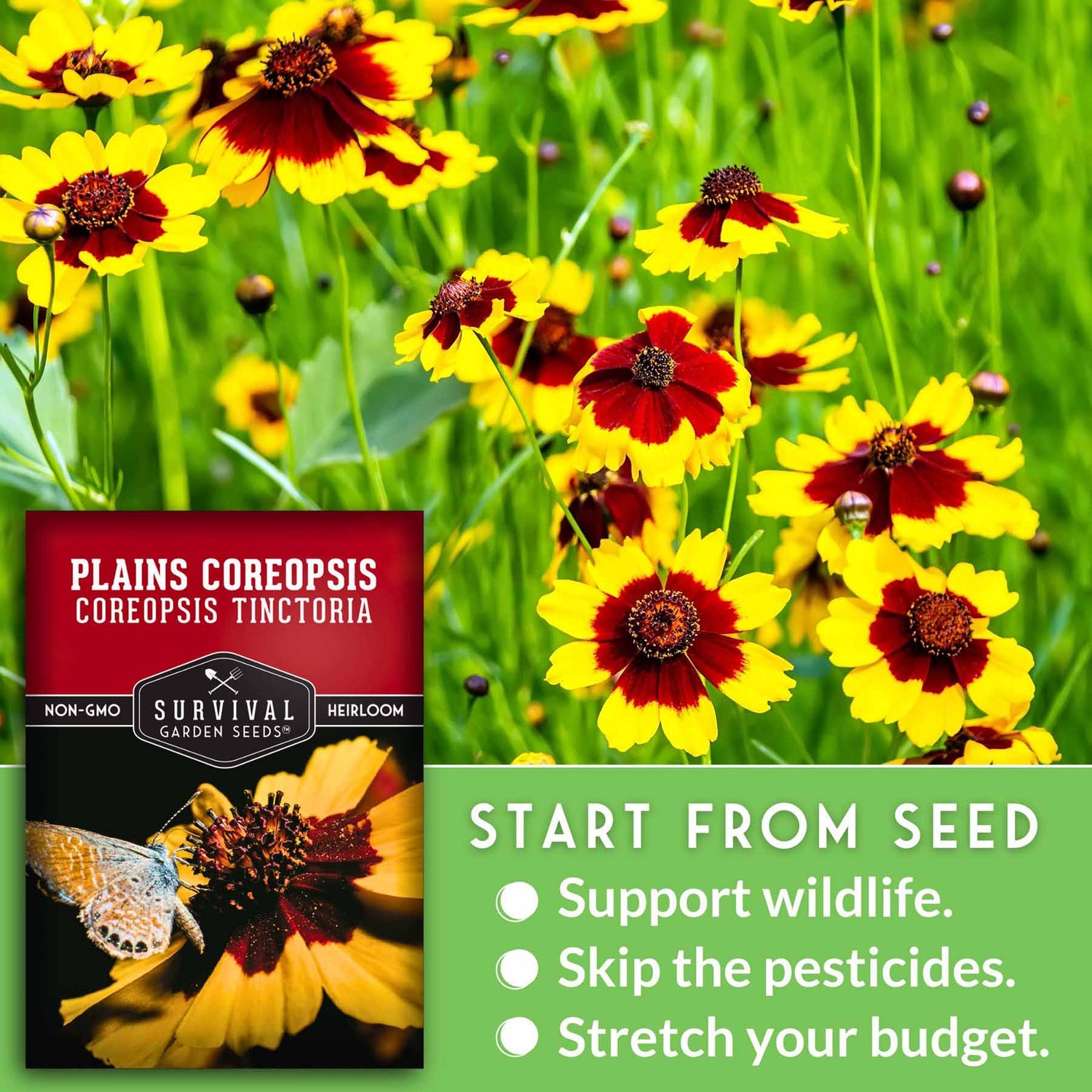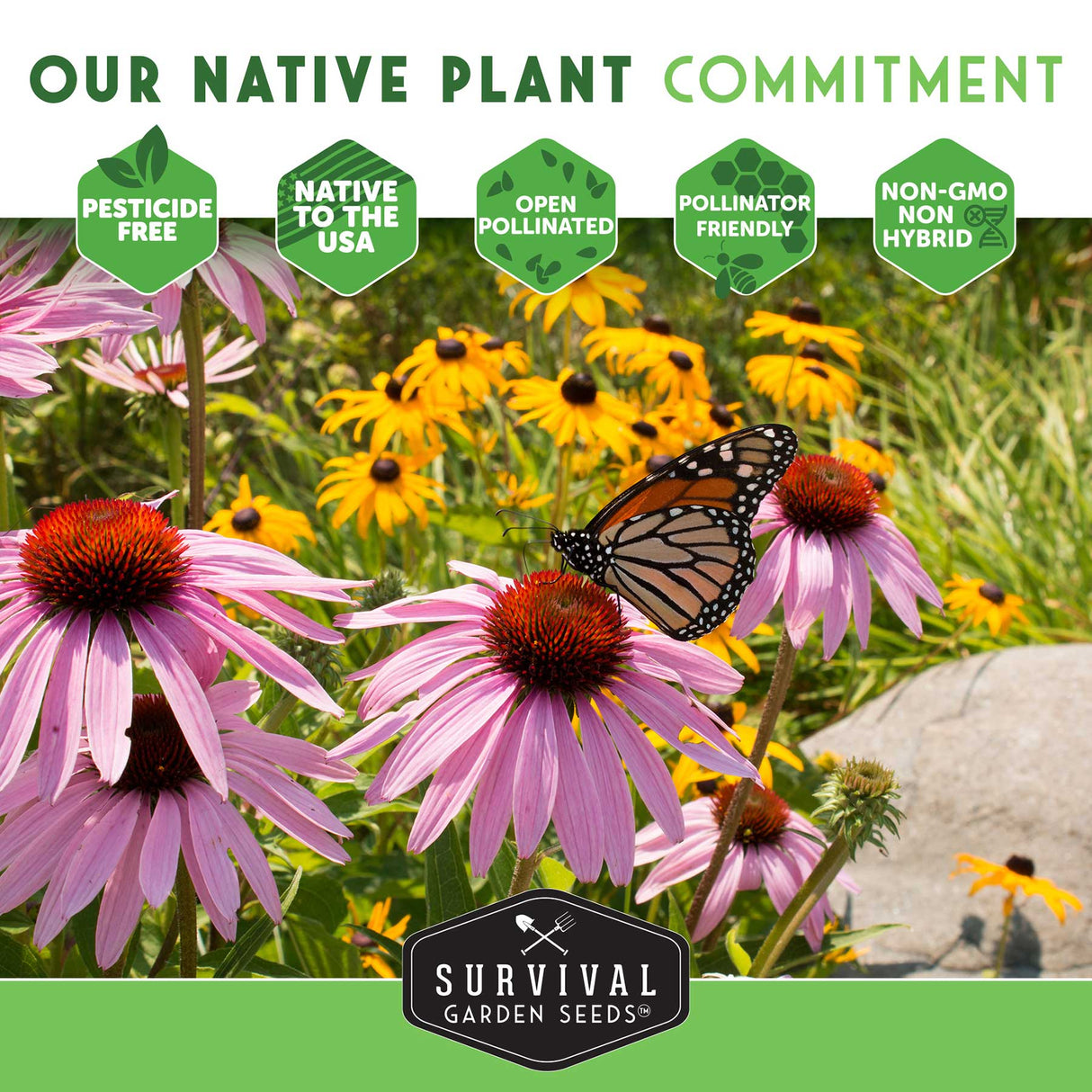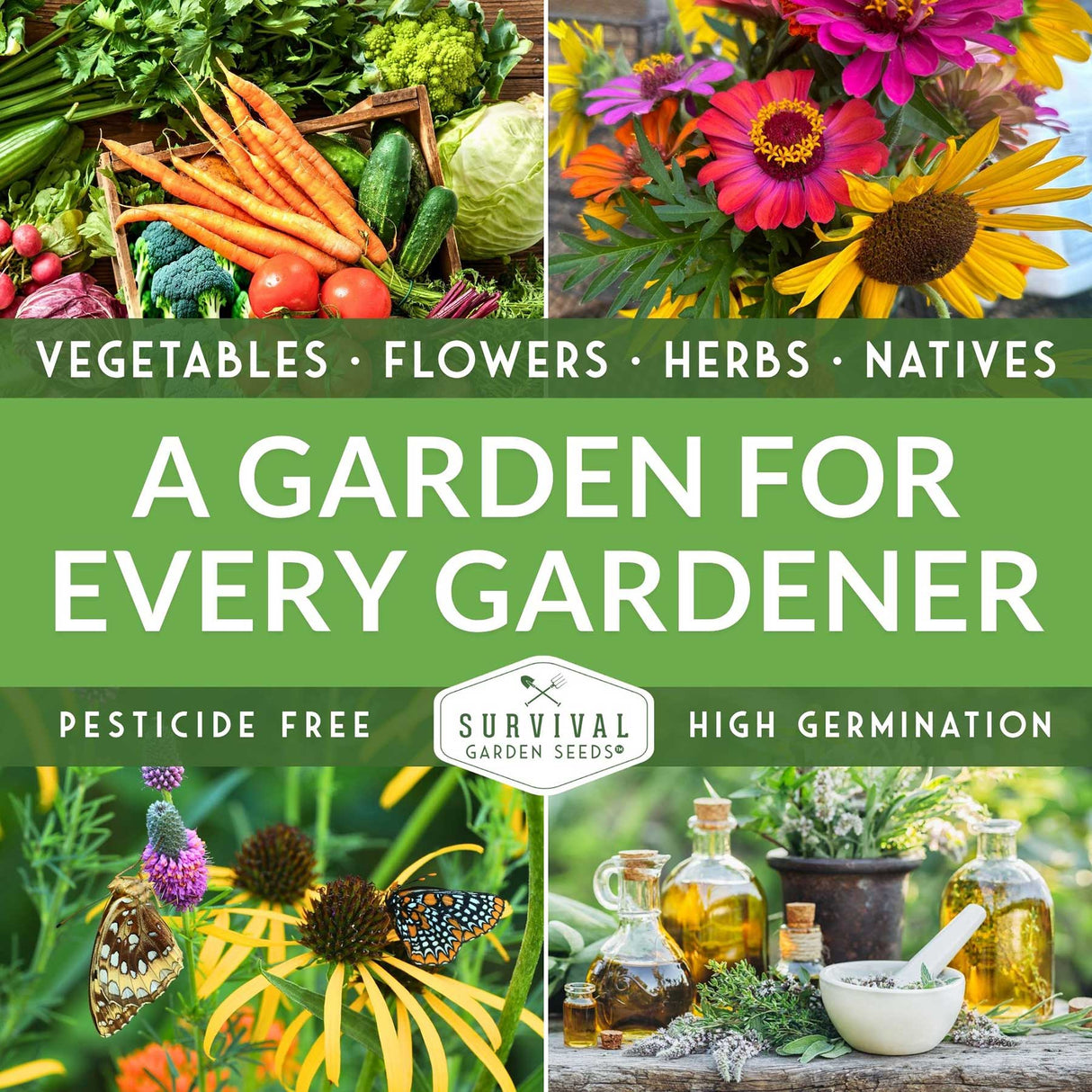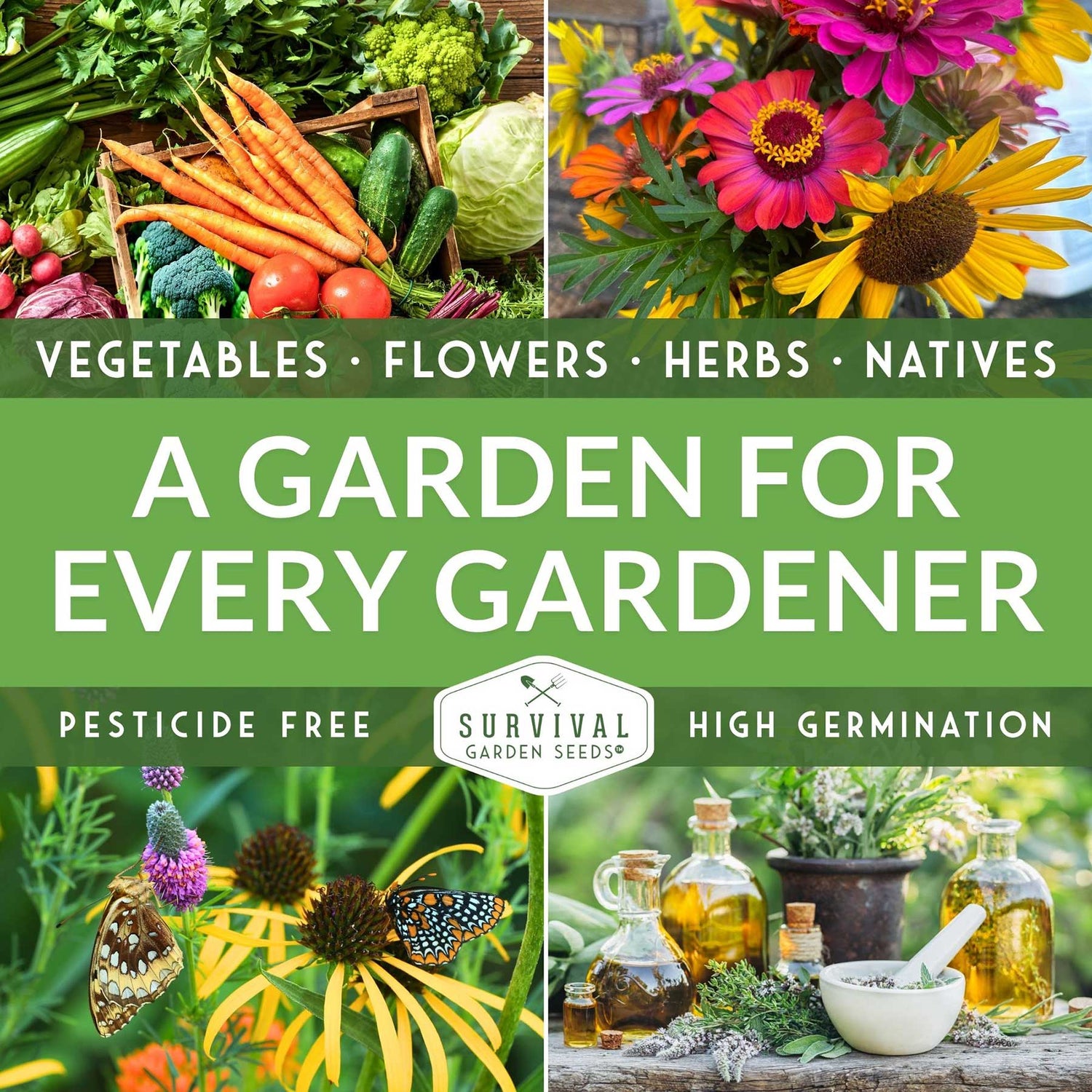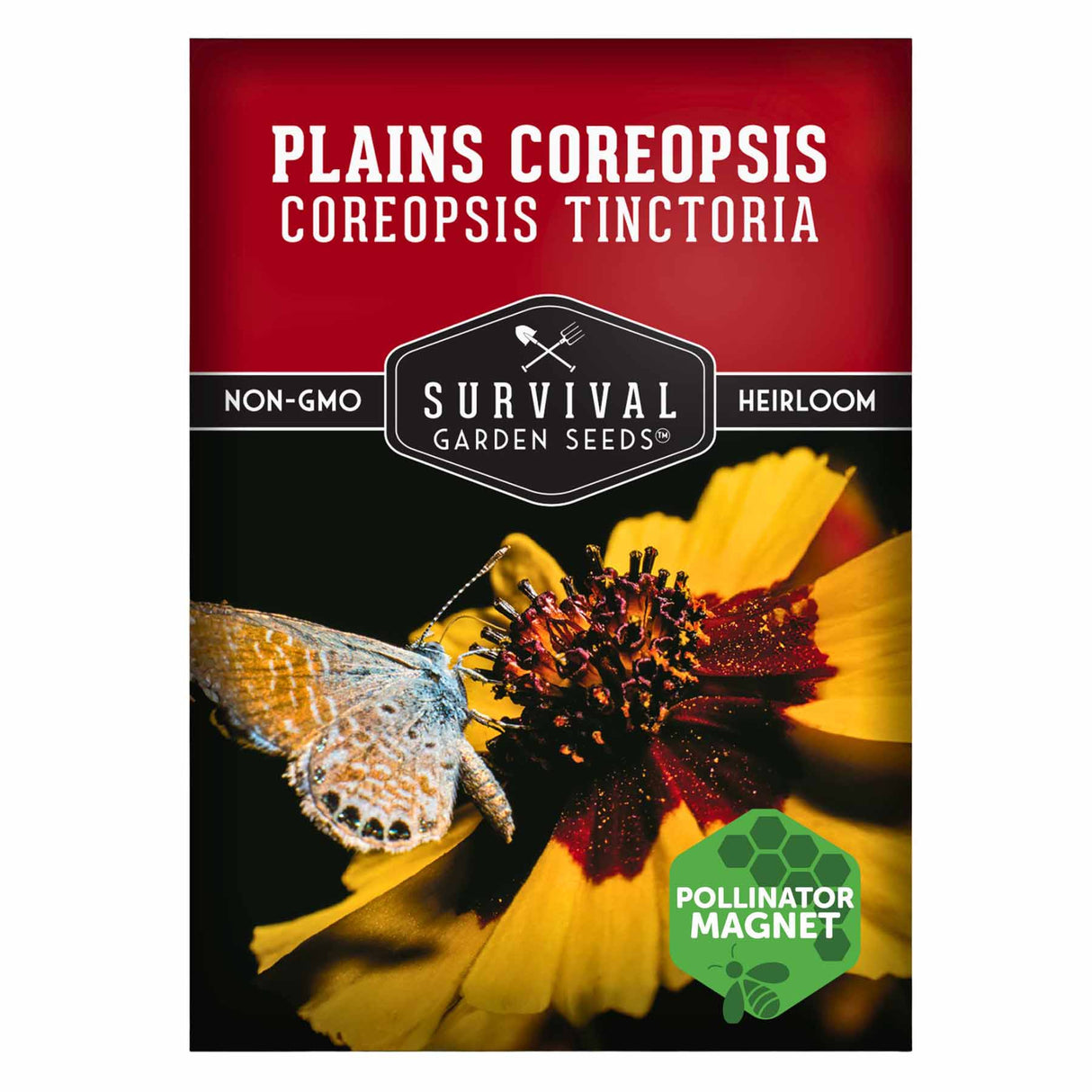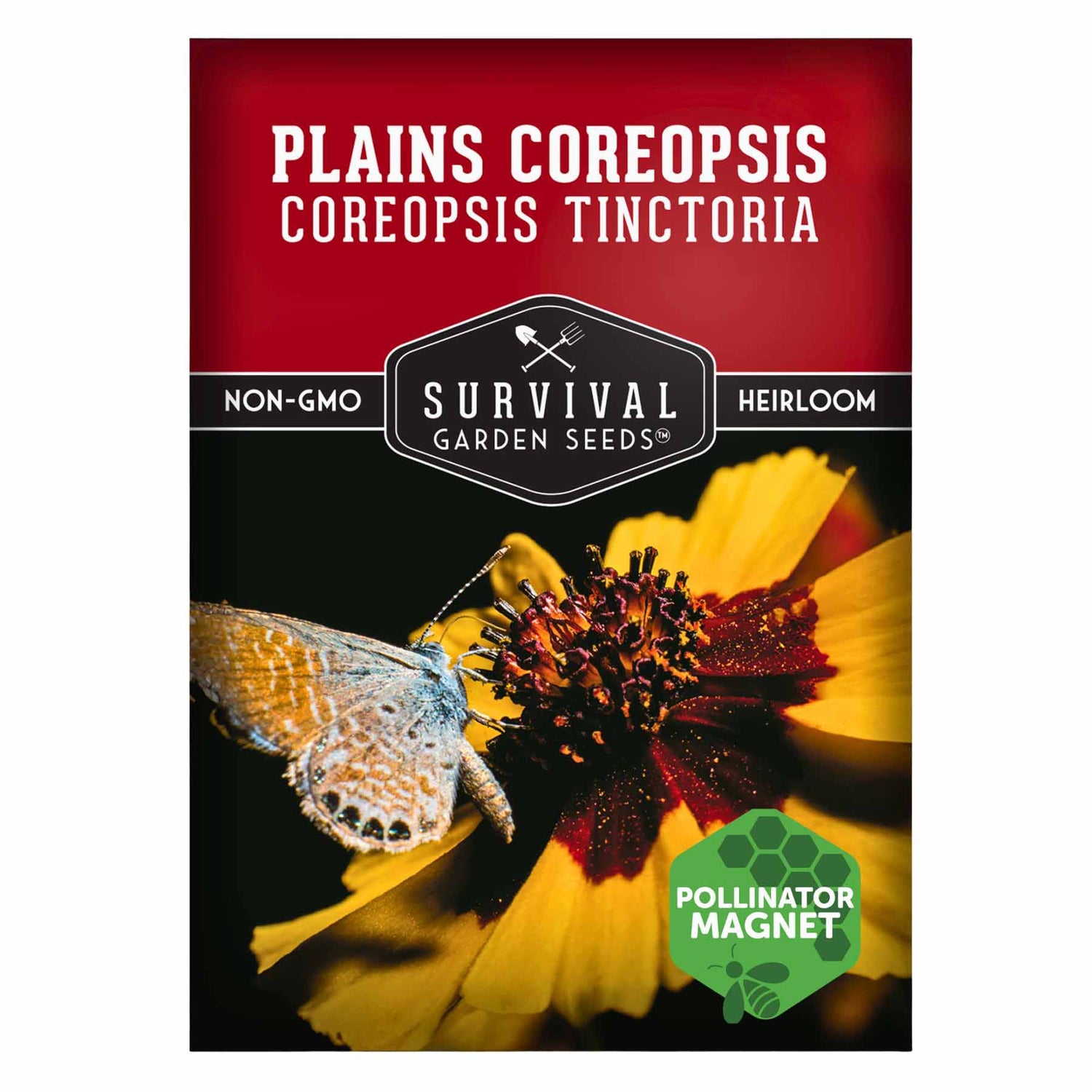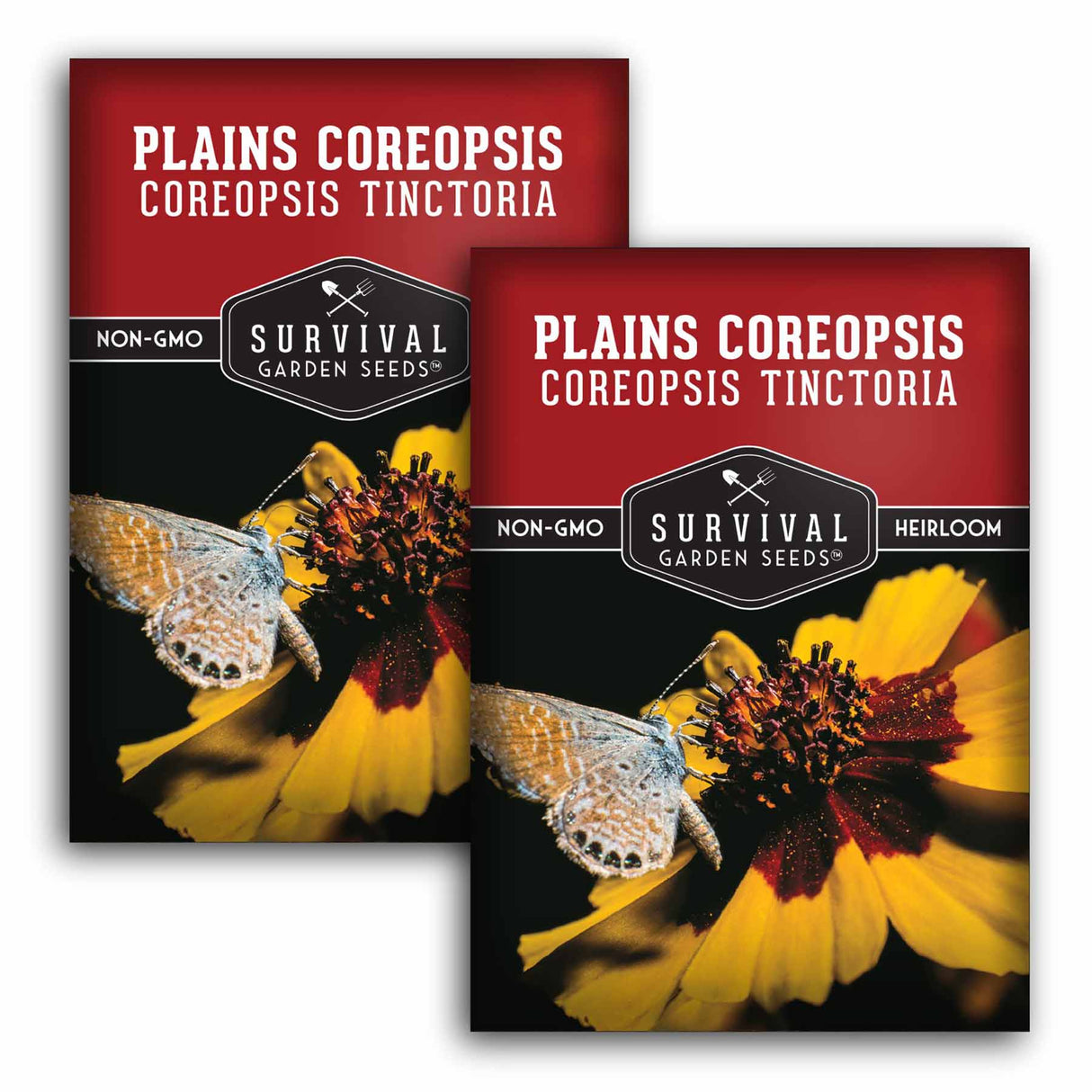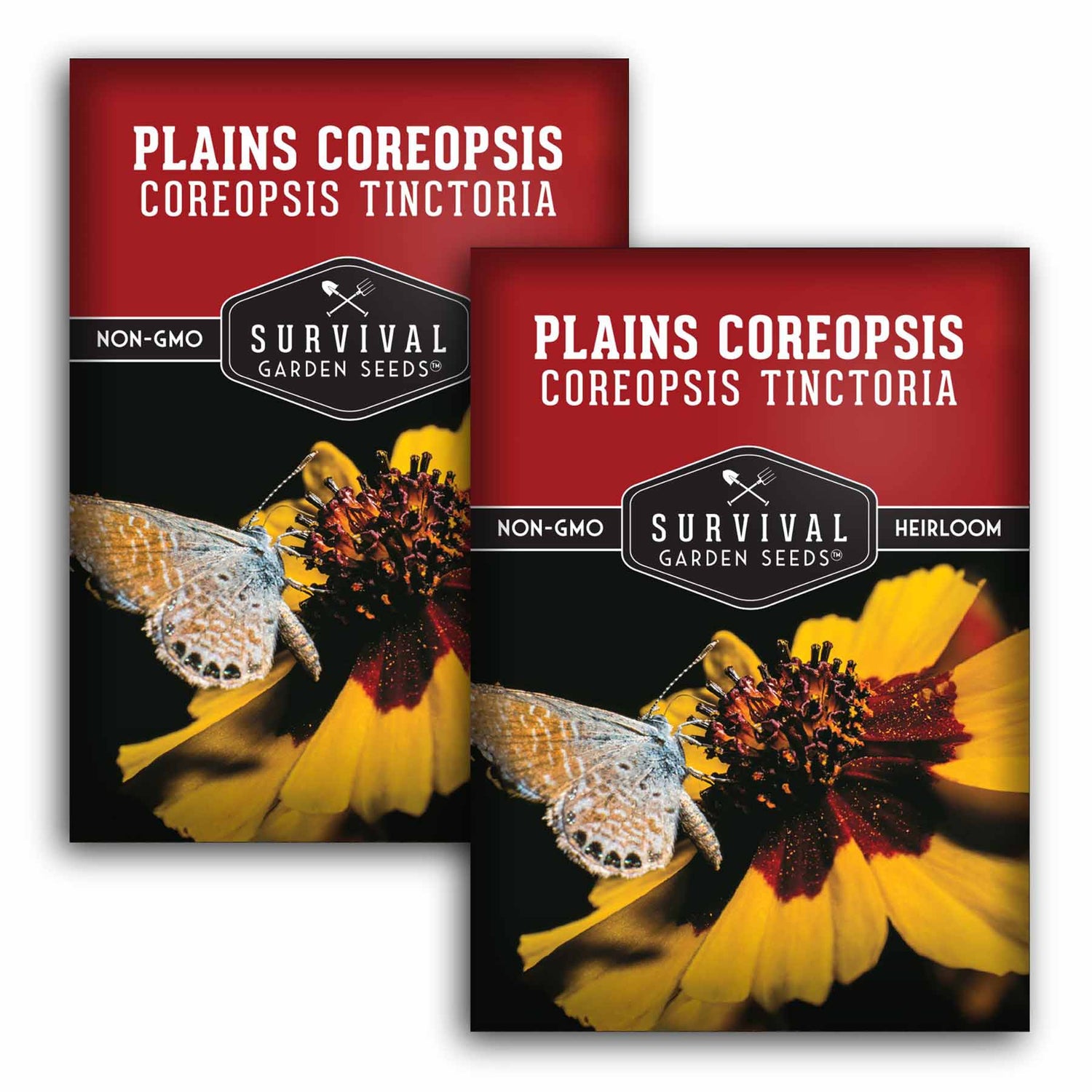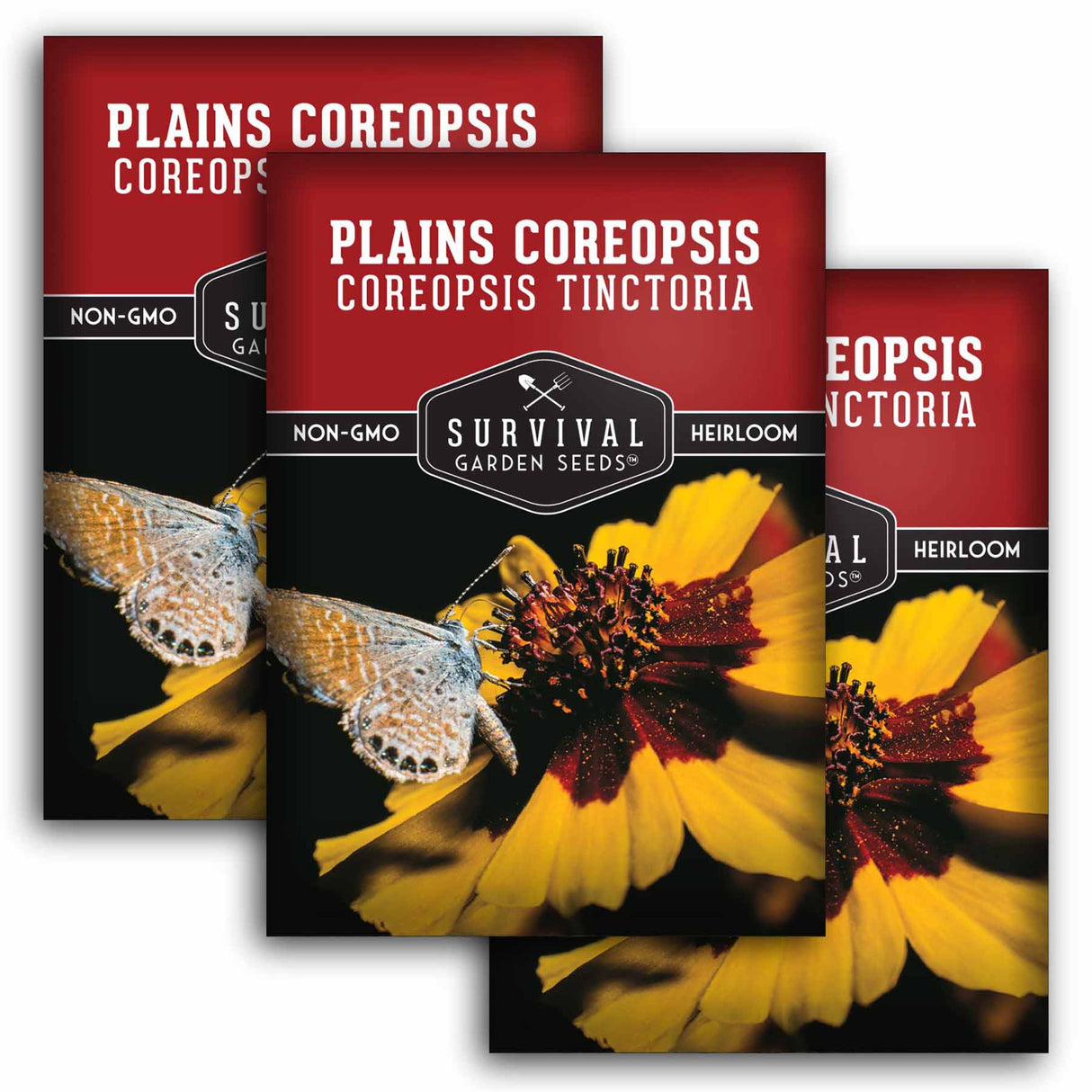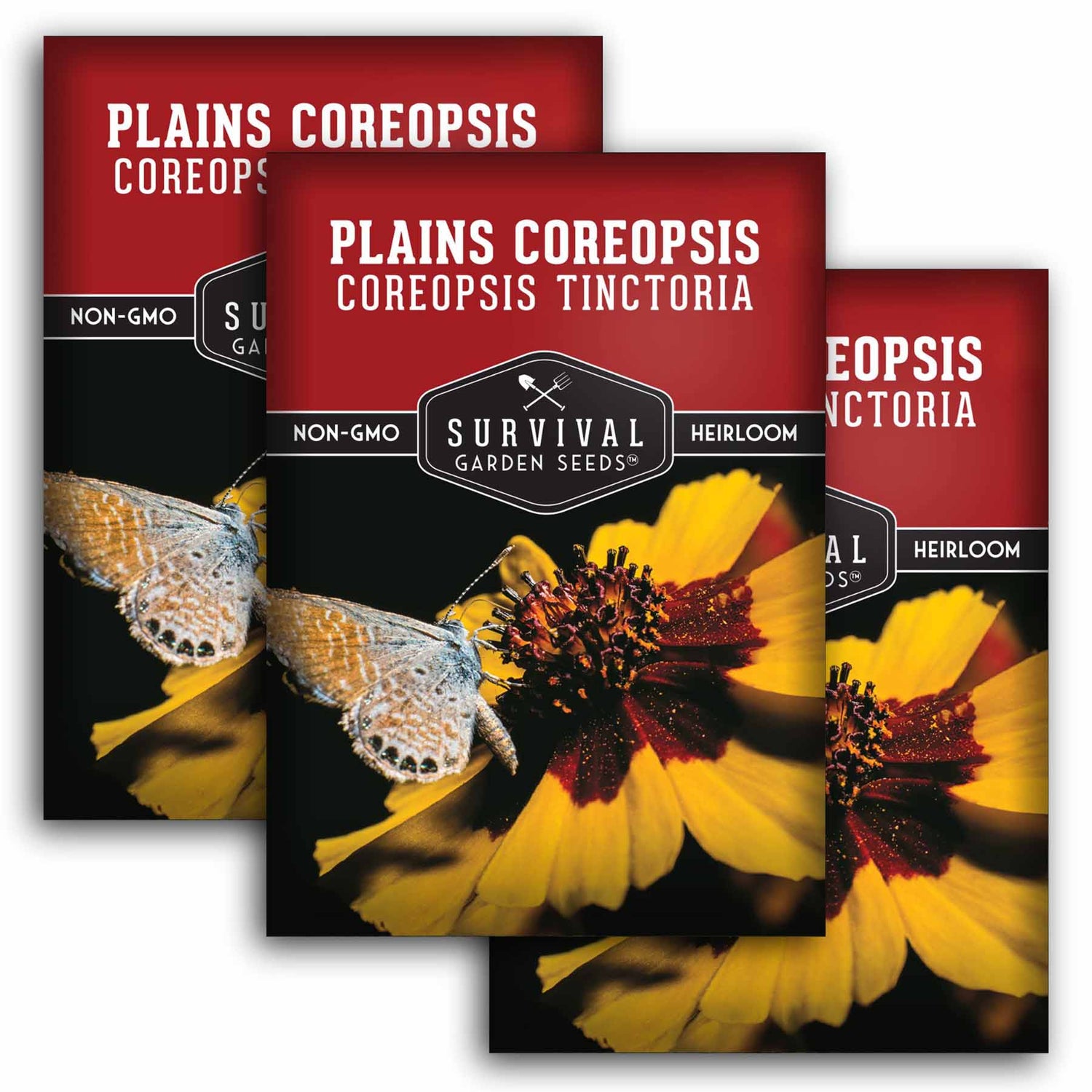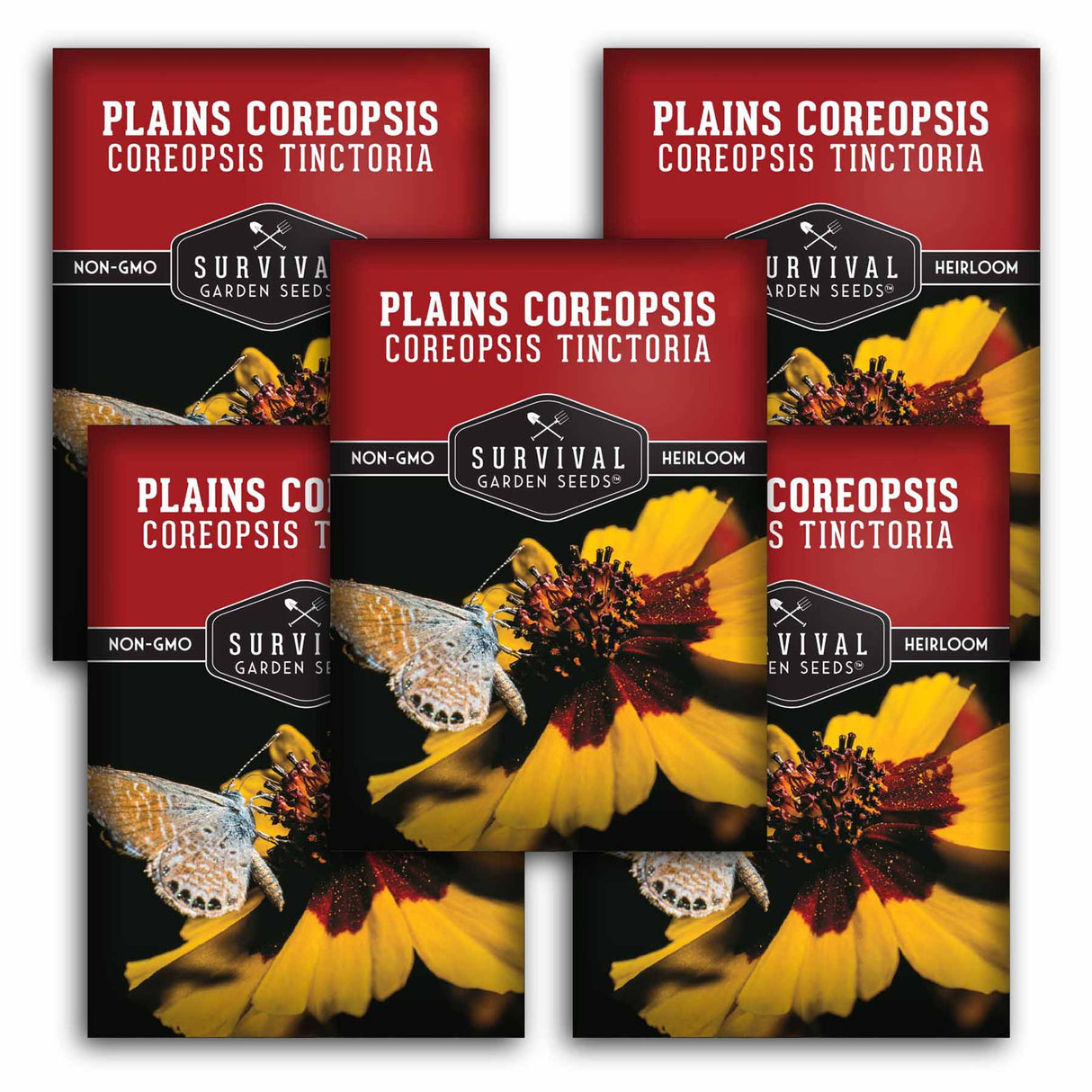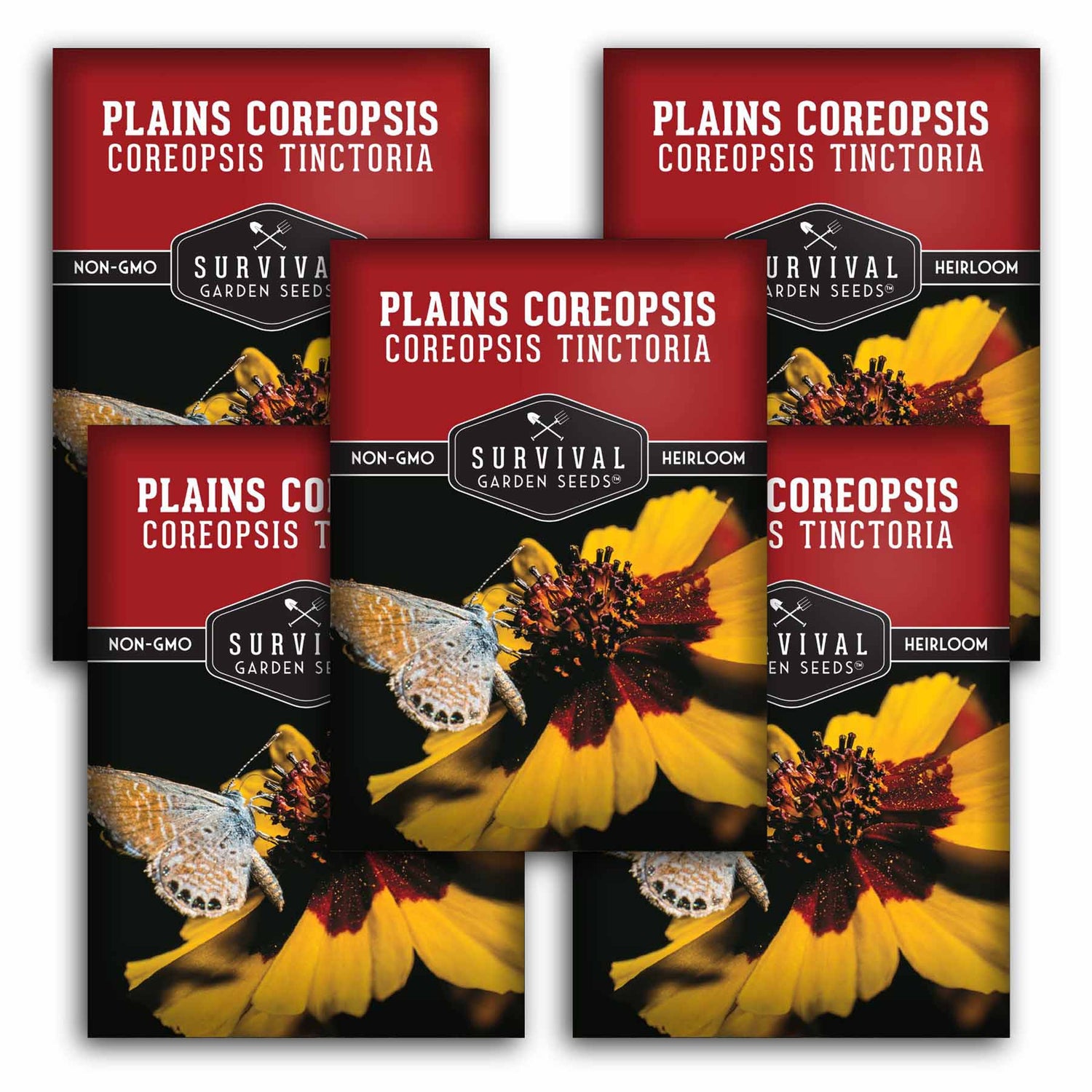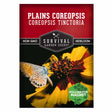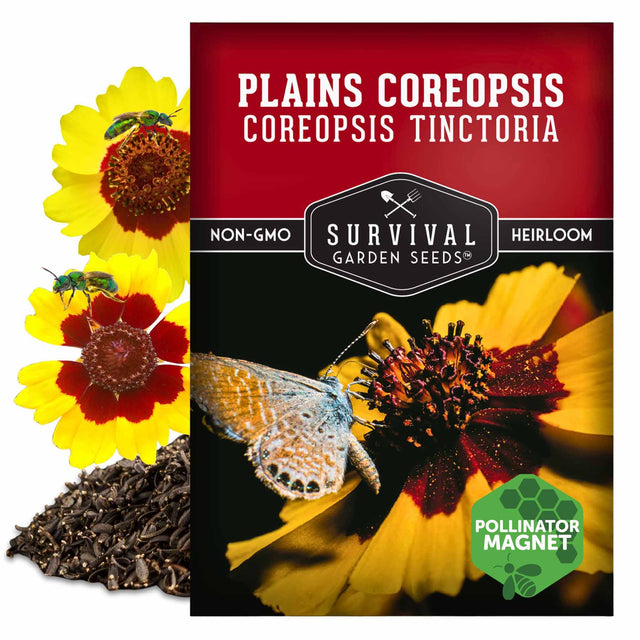Plains Coreopsis Seeds - Coreopsis tinctoria
Heirloom - Non-GMO - Reliable Germination
Plains Coreopsis Seeds - Coreopsis tinctoria - 1 Packet is backordered and will ship as soon as it is back in stock.
Couldn't load pickup availability
Plains Coreopsis is an annual North American wildflower with distinctive bicolor blooms featuring bright yellow petals crowned with rich burgundy-red centers blooming from early summer through fall. Also known as Calliopsis or Golden Tickseed, this showy annual wildflower offers versatility paired with ornamental beauty. Native Americans traditionally valued this plant for natural dyes, medicinal teas, and even as a nutritious beverage.
This adaptable prairie wildflower is ideal for beginning gardeners. It reaches 1-3 feet in height within a year, thriving in an extremely wide range of conditions, from zones 2-11 in soils ranging from dry sandy ground to moist loam. Plains Coreopsis establishes quickly from direct seeding and blooms prolifically until frost, requiring minimal care with maximum impact. Its exceptional deer resistance and ability to flourish in poor soils make it ideal for challenging garden sites where other annuals struggle.
Perfect for wildflower meadows, cutting gardens, prairie restorations, and naturalized areas, this multi-functional wildflower serves as a vital nectar source for bees, butterflies, and beneficial insects while producing abundant seeds for songbirds. Create vibrant seasonal displays while supporting wildlife with this versatile native annual flower.
- Striking bicolor flowers display bright yellow petals with burgundy-red for eye-catching displays for an extended bloom season from early summer through frost
- Exceptional pollinator magnet provides nectar for bees, butterflies, wasps, and flies while supporting beneficial lady beetles and green lacewings
- Graceful 1-3 foot stems create dense masses of delicate bicolor flowers that sway beautifully in breezes in full sun to partial shade
- Deer resistant and easy to grow, Plains Coreopsis thrives in challenging conditions with minimal care, flourishing in poor soils from dry sandy ground to moist loam
-
Multi-purpose heritage plant offers traditional uses for natural dyes, medicinal teas, and food while producing abundant seeds for songbirds
Heirloom Native Plant Seeds
All of our seeds are open-pollinated, non-GMO, heirloom varieties with tested germination rates
Specifications
Specifications
-
Botanical Name
-
Seasonality
-
Planting Zones
-
Light
-
Soil Temp for Germination
-
Germination Time
-
Planting Depth
-
Plant Size
-
Growing Instructions
-
Seed Saving Instructions
-
Seed Count (approximate)
Payment & Security
Your payment information is processed securely. We do not store credit card details nor have access to your credit card information.
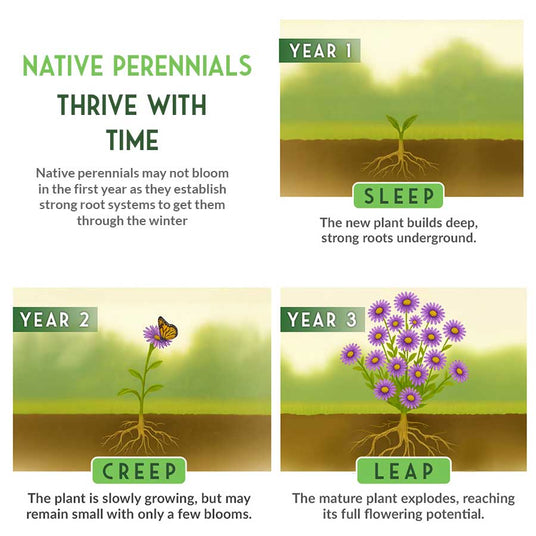
Native Perennials Are Worth The Wait!
Native perennials may not bloom in their first year. When planted from seeds, perennials put almost all of their energy into establishing strong, healthy root systems in the first year of growth. In the second year, you should see larger plants and some blooms. After the third year, you will be able to enjoy a bounty of beautiful blooms. Trust us! It will be worth the wait!
Cold Stratification Aids Germination
-
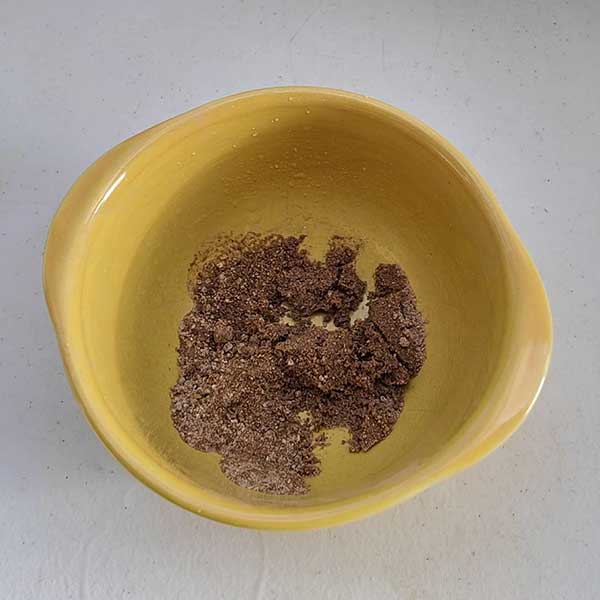
Step 1
Lightly moisten some clean sand. Make sure it is not too wet.
-
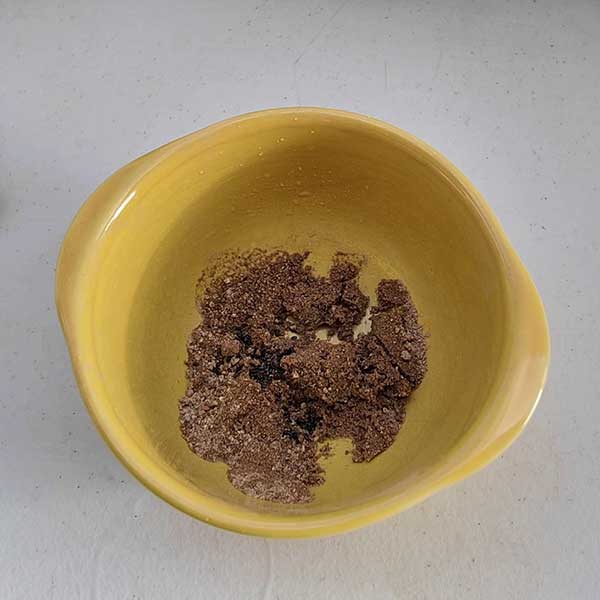
Step 2
Mix your seeds with the moist sand.
-
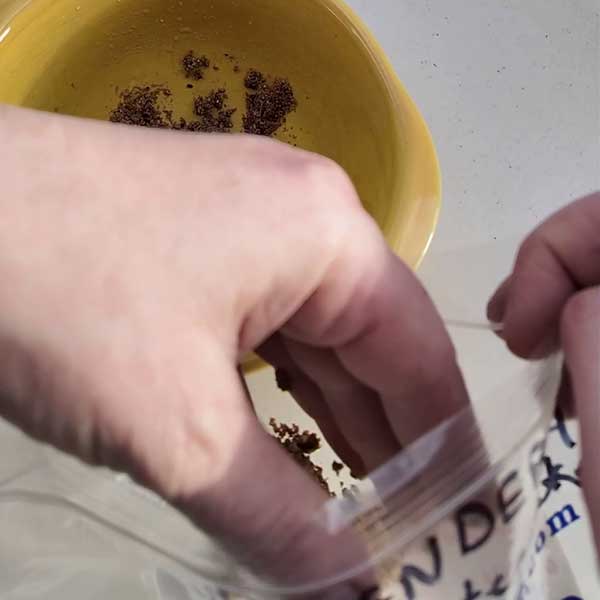
Step 3
Store your sand in an airtight container like a zip-top bag. Make sure to label and date your container.
-
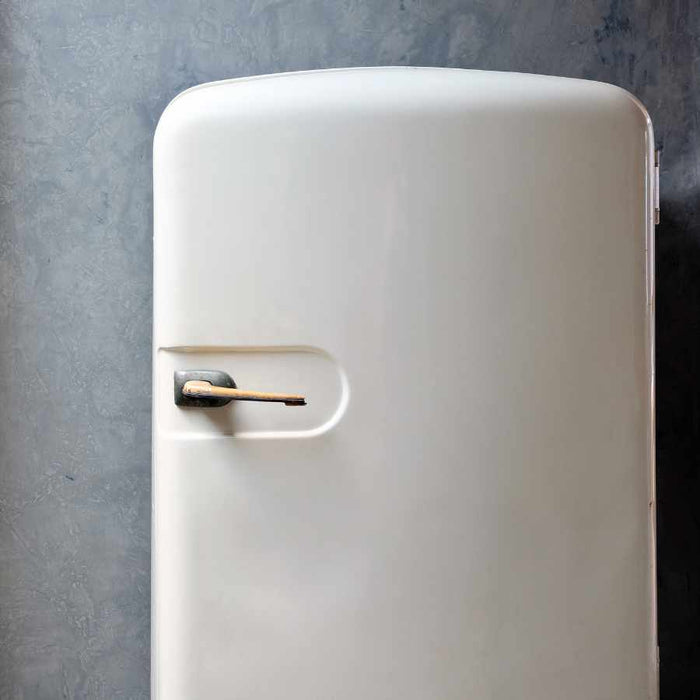
Step 4
Refrigerate your sand and seeds for 2 to 4 weeks (or more, depending on the information on your seed packet)
Support Native Habitats
- Supports Local Ecosystems and Biodiversity: Native plants are uniquely adapted to the local climate and soil conditions, forming the foundation of healthy ecosystems. They provide essential food, shelter, and breeding grounds for a wide array of native wildlife, including pollinators like bees and butterflies, birds, and beneficial insects, which helps to maintain and enhance local biodiversity.
- Requires Less Maintenance and Resources: Once established, native plants typically require significantly less water, fertilizer, and pesticides compared to non-native ornamental plants. Their deep root systems improve soil health and water penetration, reducing runoff and erosion, and their natural resistance to local pests and diseases minimizes the need for chemical interventions, saving time, money, and environmental impact.
- Contributes to Climate Resiliency and Conservation: By supporting a healthy native plant community, you are helping to create more resilient landscapes that can better withstand the impacts of climate change, such as extreme weather events. Growing native plants also plays a crucial role in conserving local plant genetics, preserving the natural heritage of a region, and providing critical habitat corridors for wildlife facing habitat loss.
- Detailed Growing Information: Paper seed packets include clear planting instructions, germination tips, and seed-saving info, great for beginner or experienced gardeners growing vegetables, herbs, flowers, or native plants.
- Trusted USA Seed Company: Family-owned business providing heirloom, non-GMO, open-pollinated seeds; always fresh, untreated, rigorously tested, and expertly packed for long-term storage and gardening success across all experience levels
Frequently Asked Questions
What are heirloom seeds?
What are heirloom seeds?
Heirloom seeds are the types of seeds your grandparents grew. These varieties have been passed down from generation to generation. They’re old reliable open-pollinated varieties that aren’t typically grown commercially. Instead, they have a rich history that predates modern breeding techniques.
You can learn more about open-pollinated, heirloom, and non-GMO seeds in our Survival Garden Training blog.
How do I know my seeds are fresh?
How do I know my seeds are fresh?
Every seed packet includes a "packed for" date, and we germination test each seed lot before packaging to ensure you receive viable, high-quality seeds that are ready to grow.
Are your seeds treated?
Are your seeds treated?
No, we do not pre-treat our farmer seeds. All of our garden seeds for sale are untreated, open-pollinated, non-GMO, and heirloom varieties. They are kept in temperature-controlled cooler storage until they are packed and shipped to keep them pest and disease-free.
In what zones can I grow your seeds?
In what zones can I grow your seeds?
The seeds in our collections are specifically chosen from varieties that can be successfully grown from Zone 3 to Zone 10 USDA Hardiness Zones. However, individual varieties have specific needs to thrive in different environments. Each seed pack has optimal temperatures for germination and instructions on seed starting. Consult local frost dates to plan your garden and get the most out of your seeds.
What is the shelf life of these gardening seeds?
What is the shelf life of these gardening seeds?
Most seeds remain viable for 3 to 5 years or longer when stored properly. Check your seed packet for specific varieties. For best results, keep your seeds in a cool, dry place away from direct sunlight and moisture. Store them in an airtight container in a consistent temperature environment—a refrigerator or cool basement works well. Proper storage helps maintain germination rates and extends seed life well beyond the packed date.
Where are Survival Garden Seeds sourced?
Where are Survival Garden Seeds sourced?
The majority of our seeds are sourced in the United States, with a few exceptions when the seed is difficult to source domestically. Whenever we do have to source outside of the US, we ensure our seeds are safe to grow, non-GMO varieties that meet our standards for germination and reliability.
